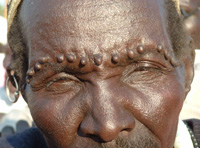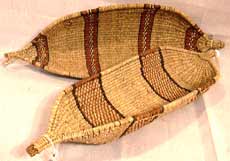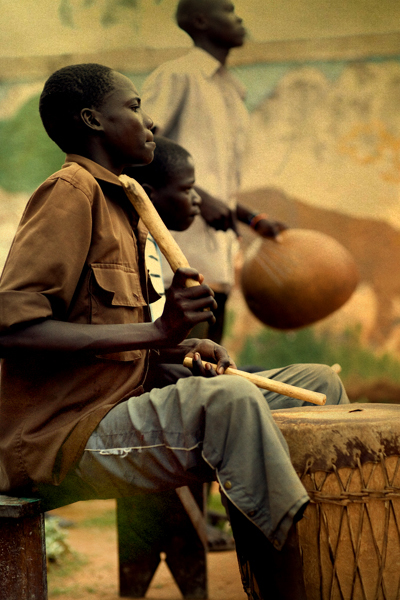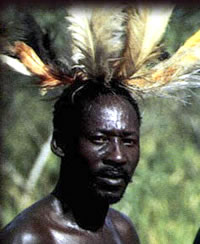



The Luo of Sudan:
The Luos of Sudan are faced with the same predicament that faced all Luo ethnic groups in surrounding African countries, which are the questions of migration and origin in Africa; predicament which mostly centred around conflict in the Luo family and certain break-up. Among the Luo ethnic groups in Sudan, there is common believe that, all (Luo groups) are part of the larger Luo ethnic family that made up of all the Luos in Sudan, and the surrounding African countries of Kenya, Uganda, Tanzania, DR. Congo and Ethiopia (Stefano P. Sant Andrea: 1938)
The Jo-Luo of Wau in Southern Sudan in particular link themselves to their Great ancestor (Dimo), who is a brother of (Niykango), the great ancestor of the Luo Shilluk in Upper Nile, Southern Sudan, and the founder of Luo Shilluk Kingdom. Gray, Richard, (1961) As far as Sudan is concerned the Luo-Shilluk represent the largest Luo ethnic subgroup in Sudan.
Luo mythology and oral history cited “Geilo” as the youngest brother of Dimo and Niykango. This account of oral history and myth within Luo groups in Southern Sudan refers to Niykango as the older brother of the three brothers, and the most autocratic sibling in the family. And the assumption indicates that due to his autocratic personality, a rift has taken place in the family, which subsequently caused the break-up among the three brothers.
According to St. Andrea (1938) the group broke-up due to family disputes, which subsequently led to group, and social disintegrations among the Luos’ of Sudan. This dispute was mostly cited between Niykango and Dimo, with limited references to Gilo their third brother and the great ancestor of Anyuak Luo group, and the founder of Anyuak kingdom in Upper Nile, Southern Sudan (1938)
According to Luo culture, there is a custom of moral expectation and line of respect that governs family members according to the birth order, which indicates that older siblings are not to be questioned or confronted, even if they are wrong. This may be the reason why Geilo was not mentioned in the dispute between Dimo and Niykango. As such Niykango determined the direction of how the dispute has be resolved. This may be the reason why Gilo came along with Niykango to migrate westward to the current settlement in the Upper Nile region, Southern Sudan. Gilo in his adulthood subsequently decided to break-up with his group the Anuak and from a separate kingdom.
The Luo Anuak of Upper Nile, southern Sudan links themselves to “Geilo” as their great ancestor. Gilo formed his kingdom in similar style as Niykango and moved to the current settlement in the border between Sudan and Ethiopia. The Anuak maintained the same strict line of linage as their cousins, the Shilluk, as an indication of the influence of his older brother on his style of leadership.
In this context, the Luo of Equatoria in Southern Sudan; for example, Acholi and Parri, in addition to Luo ethnic group that migrated to Kenya, and Uganda are not clearly cited in this piece of the history of ancestral linkages. However, it is possible that most of these Luo ethnic groups, with exception of Shilluk (Shula) and Anuak, are decedents of either Dimo or Geilo. (Gilly, Leoma: 1992)
The ancestral linkages are of particular importance in the Luo of Bahr El-Ghazal cultures and customs. Their understanding of ancestry through oral history that has been passed along the generations has made the trace of their line of linkages to other Luo groups much easier. In addition, they manage to keep their language and Luo ethnic names such as Dimo, Kang, Ukeilo and Gielo to present; names that are given after their great ancestors. The ancestry, as Mary Borer (1963) found in the religion of African Bantus, are of particular importance, as they maintain the well being of the family and groups even after the death. (1963:p76). The Luo of Bahr El-Ghazal also value their ancestral, and belief in life after death, the practice that has facilitated their acceptance to Christianity during the colonial era.
As far as Southern Sudan is concerned, there are Luo Shilluk and Anyuak in Upper Nile Region—Acholi and Jo-Pariri in Equatoria Region, and Jo-Luo, Thurri and Bor in East and western Bhar El-Ghazal, region. Accordingly, and for the propose of this study, these Luo ethnic groups in Southern Sudan are to be further explored and discussed in context of their geography, regions, cities, populations, and ethnic classifications.
The Luo Shilluk/Shoula: (Sudan)
As noted earlier, Shilluk are cited as the descendent of the great Luo ancestor named Niykango, who is the first founder of Luo kingdom in Africa. Most Luo oral history and myths acknowledged Niykango as the elder son, and the person who have caused disunity, group disintegration and family breakdown within the greater Luo ethnic group in Sudan before their migrations into other part of Africa. These series of disputes subsequently led to further displacements and migrations of groups internally in Southern, and externally to surrounding African countries. (Seligman, C. G., and Seligman, B. Z: 1932)
After this disputes between Niykango and his brother Dimo, Niykango, with his charismatic leadership has managed to Institute first Luo Kingdom in the Upper Nile region in Southern Sudan that has been sustained by his descendent (Shilluk group) to the present day. Kings in the Luo Shilluk groups are traditionally known as “Ruth”. (1932) The Ruth (Kings) in Luo Shilluk are selected according to bloodline.
According to Gilly, Leoma (1992), the Luo Shilluk group live in Southern Sudan Region, Upper Nile State occupying the land between Nile to the verge of Kurdofan Province, from Latitude 11 in the north to about 80 miles west of Tonga; also on the east bank of the Nile around the junction of the Nile and sobat river for about 20 miles.
According to (1982) census, the population of Shilluk was set at 175, 000 people, making Shilluk the largest Luo ethnic group in Sudan. The Shilluk are classified as Nilo-Saharan, Eastern Sudanic, and Nilotics. The Shilluk are also known as, Colo, Shulla; which literally mean a “black” in Luo language. Gilly, Leoma (1992), cited that majority of Shilluk practice African religions and Christianity.
The Anyuak are descendents of Gielo, the third brother/younger brother of Niykango and Dimo Luo’s great ancestors who migrated from Bhar El- Ghazal to the Upper Nile region with his eldest brother Niykango. Gielo, subsequently left Niykango with his descendents, and founded a separate kingdom sustained by his people (the Anyuak) to the present date.
The Anuak are located in villages of Pibor and Lower Akobo rivers. From Akobo post to latitude 6.45 North. The Anyuak are also known as Anywa, Yambo, Jambo, Nuro and Anyuak. The Anyuak are classified as Nilo-Saharan, Eastern Sudanic, Nilotics, and Luo. (Collins, Robert O.: 1971)
The Jo-Luo: (Jur)
Between the Jo-Luo (Jur) of Bhar El-Ghazal, the assumption is that Dimo is the sibling who left his two brothers (Niykango & Gilo) and migrated down to where they currently are. (North and Western Bahr El-Ghazal Region in Southern Sudan). There is a general consensus among the Luo groups of Bahr el Ghazal that the cause of the break-up was due to family dispute and power struggle. This consensus is also supported by other Luo groups’ oral history and mythology. (Stefano P. Sant Andrea: 938).
According to 1983 census the Jo-Luo population numbering between 80,000 to 100,000 people in Bahr El-Ghazal region. The Jo-Luo are found in Southern Sudan Region, north of Wau as far as Gaite, Kiango, Udici, Gana, Barmayen, Fongo up to Aweil and Southeast of Wau which includes surrounding suburbs of southeast of Wau, Waadlyiela, Barwoul, Pambili (Umbili), Aya Kwajina, Mapel, Bar urood up to Tong (1938).
Locals (Dinka) in Bhar el-Ghazal Region Southern Sudan call the Jo-Luo’s as Jur Chol; a nick name which means “black stranger”. The Jo-Luo also refer to themselves as Luwo, Jo-luoi, and are classified as Nilo-Saharan, Eastern Sudanic Nilotic, Western, Luo, Northern, Jur. The Luo are also known for their positive attitudes toward learning different languages and dialects. Most of the Jo-Luo speaks Arabic, Dinka, Bongo and English. The Jo-Luo are forest agriculturists and iron miners. The Jo- Luo were forbidden during English rule (1855-1956) not to produce, or mine iron. Many who continue to practice mining were either jailed, or killed (1938).
Ronald Atkinson (1994) has cited the Iron working technique, and its practice among the Luo Achuli as early as 1000 B.C. (1994p58). Hence, the practice of Ironwork could be either one of elements that made this groups always choose their habitations around rivers and lakes. As such, it would be fair to say that archaeological work, and genetic analysis could further reveal more evidence of ethnicity, and ethnic relationship among the Nilotics in general, and the Luo groups in particular.
The Luo (Jur) main sources of economy are blacksmithing, agriculture, hunting, production of Bee Honey and fishing. They have perfected these trades over centuries and have shared their knowledge with neighbouring ethnic groups. Their knowledge of geology and geography has helped them in surviving through their migration and settlement in new territories. It has also helped them co-exist with, and assimilate other ethnic groups into Luo groups in East Africa. The Luo mainly believe in traditional African religion, which have strong links to Judaism (Old Testament) and Christianity. The Luo’s believe in prophets, and they use them as a link between them and the Most High (god). The Luo’s acknowledge their being in relations to their ancestors, thus receive their blessings through them. (Pace, Wanda: 1991)
Luo Bori: (Belanda-Bor):
The Luo Bori ethnic group, or Pa-Bor were actually part of the larger Luo clan of the Luwo Ethnic group of Bahr el Ghazal at some point. Their great grand father named (Utho) According to St. Andrea who left his group (Dimo Group) for undocumented reason and moved to live around Belanda Bviri in Zandi Land in western Bahr el Ghazal. Accordingly, the Luo Bori become known as “Belanda” a section of Bantu ethnic group in Southern Sudan. On that note however, the Luo Bori managed to keep their Luo language and the origin of their Luo ethnic traditional names. Pace, Wanda (1991). Belenda Biviri are ethnic Bantu group found in Bhar El-Ghazal Southern Sudan.
In addition, the Luo Bori has intermarried with Belanda Bviri and speak Belanda Pivri Language as well. The Luo Bori linked to their great ancestor “Utho” a descendents of (Dimo) as a great grand father. The Luo Bori is classified as Nilo-Saharan, Eastern Sudanic, Nilotic, Luo, and Bor (St Andrea: 1938).
The Luo Bor group numbering about 8000 people according to (1983 SIL) census. They are found in Western Bahr El-Ghazal Region in villages of RaffiI, Tirga, Bazia, Ayo, Gitten and Taban. The Luo Bori are also found in the Western Equatoria Region of Southern Sudan in the Villages of Komai, Bangazegion and Tumbra (St Andrea: 938).
Thuri (Boodho/Shatt)
Thurri are referred to as Shilluk of Bahr El-Ghazal, as St Andrea (1938) thinks that they are part of Niykango/Shilluk group whom are left behind when the Niykango group migrated to Upper Nile Region where they are currently settled. Locals in Southern Sudan also refer to Luo Thurri tribe, as Jur-Shatt, Boodho or Jur-Chol. The Luo Thurri are found in Southern Sudan in areas between Wau and Aweil in Northern and Western Bhar El Ghazal. The Luo Thurri are also located between Jur and Lol rivers, on Raja Nyamlell road, and up to Wau-Deim Zubeir road. The Luo Thurri population was estimated at about 16,720 according to (2000 WCD) census. The Luo Thurri are also classified as Nilo-Saharan, Eastern Sudanic, Nilotic, Luo, Thuri (1938).
A section of Luo Thurri known as (Jur-Manangeer) has completely assimilated with their neighbouring Dinka of Western Bahr El- Gazal. It is possible socio-cultural interactions and intermarriages have facilitated the assimilation process. This section of Luo Thurri no longer refers to themselves as Luo or Thurri, and do not speak Luo Thuri Language (De Boodho) any more (1938).
The Luo Thuri main source of economy is agriculture, fishing, hunting and Honey Bees production. Gilley, Leoma (2004). The Luo Thuri are best known as professional hunters and cross country long distance walkers (2004).
The Acholi:
The Acholi Luo group is traced to chief “Olum” as their great ancestor who at some point led major Luo tribe around Rumbek (Lakes Region in southern Sudan). Olum appeared in the Luo history after the separation of Dimo, Nyikango and Geilo. Chief Olum subsequently moved southward along the river Nile and resettled at Pubungu near Pakwach in eastern equatorial, southern Sudan. Chief Olum has been cited as having three children namely, Gapiir (Nyapir), Labongo (Kyebambi) and Tiful. (Ogot, B.A.: 1997).
These three brothers latter branched out and latter formed Luo tribes that currently known as Alur and Acholi. Ethnologist failed to record, or follow migration pattern of the third brother Tiful. Gabiir (Nyapir) was cited in this process as the great ancestor of Luo Alur, and Labongo (Kyebambi) as a great grand ancestor of the Acholi’s (Wild J.V.: 1954).
Accordingly, it is possible to say that Acholis are the descendent of Labongo the son of Olum who led the Luo groups from Southern Sudan to Pubungo along the river Nile. The Acholi are found in Southern Sudan, Equatoria Region, Opari District and Acholi Hill, with a population of 45000(2000), and in Uganda, with a population of 746, 796 (1991 census). The Acholi are classified as Nilo-Saharan Eastern Sudanic, Luo, Southern, Luo-Acholi, Alur-Acholi and Lango-Acholi. They are also known as Acoli, Shuli, Gang and Lwo. The Acholi are known as professional agriculturists, hunter, and fishers. In addition, the Luo Acholi group has been practicing iron working and mining for centuries (Wild J.V: 1954).
The Jo-Parri (Logoro)
The literature of Luo history, and Mythology clearly cite the Jo-parri as direct decedents of Luo great ancestor Dimo. Moreover, there is a strong belief among the Jo-parri that Lipul Hill is were Dimo and his elder brother Nyikango separated, and subsequently formed the two groups of Jo-Dimo and Jo-Nykango. According this account, Dimo has moved towards Pugeri Village and settled there with his group (the Jo-Parri). Other group continued south toward Uganda and formed group currently known as Adhola. This began the migration and later facilitated a way for other Luo groups to later join and crossed over to Kenya. The Jo-Parri named the first point of the division, and separation of the Luo ethnic groups “ Wi-Pach” in Eastern Bhar el-Ghazal, Southern Sudan (Tosh, John: 1978).
The Jo-Parri are known as professional agriculturists, hunter, fishers and also raised large number of Cattle and Goats. They cultivate Sorghum, cowpeas, Pumpkin, Okra and Tobacco. The Jo-Parri still maintained an original Luo ethnic group language, which is eassy to understand by the rest of Luo groups in Africa, and closest to Luo Anuak, and Jo-Luo of Western/Eastern Bhar el-Ghazal. (Murrdock, Peter George: 1959).
- Home
- ABOUT THE LUO OF BG
- Community Events
- CURRENT PROJECTS
- HOME NEWS
- DIASPORA
- LUO OF BHAR EL GHAZAL IN AMERICA
- HISTORICAL PRESPECTIVES
- OPINIONS
- CULTURE
- LUO IN AFRICA
- LUO IN SUDAN
- THE EXECUTIVE COMMITTEE
- UPDATES AND COMMENTS
- GOVERNMENT OF WESTERN BHAR EL GHAZAL
- GOVERNMENT OF NORTHERN B G
- CONTACT US
- Conference 2009
- Luo Youth Connection
- Luo Business
- Southern Sudan TV LIVE
- Jo-Luo Internet RadioTV-Live
- Luo Community Conference 2016